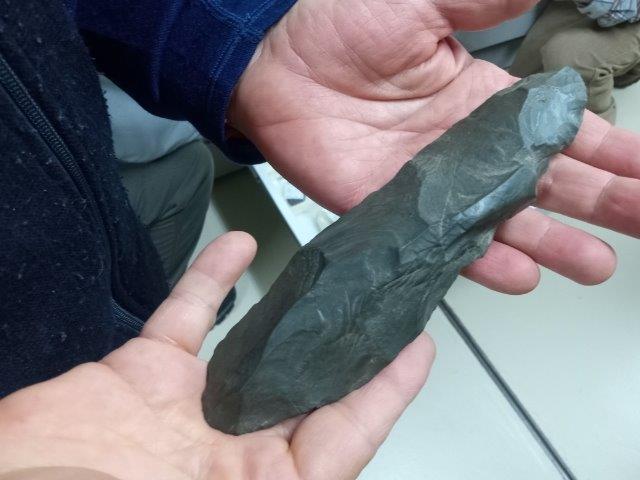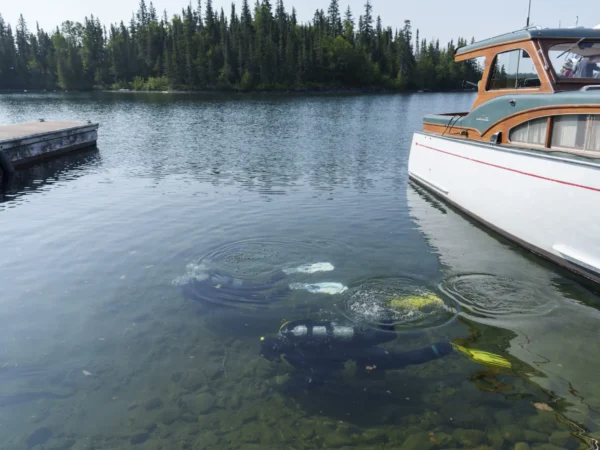
Editor’s Note: “Nibi Chronicles,” a monthly Great Lakes Now feature, is written by Staci Lola Drouillard. A direct descendant of the Grand Portage Band of Ojibwe, she lives and works in Grand Marais on Minnesota’s North Shore of Lake Superior. Her two books “Walking the Old Road: A People’s History of Chippewa City and the Grand Marais Anishinaabe” and “Seven Aunts” were published 2019 and 2022, and she is at work on a children’s story. “Nibi” is a word for water in Ojibwe, and these features explore the intersection of indigenous history and culture in the modern-day Great Lakes region.
“They mean so terribly much. When you consider the work and the history behind them.”
Louella (Lego) Anderson instinctively knew how to hold a knife that was pounded into being 7,000 years ago. Shaped like a shallow “C”, the copper instrument was used to slice things up into smaller pieces and tough enough to cut through hide or bone. And 7,000 years later, that knife is still sharp.
I knew her as Lou when I was growing up. She and her husband Richard (Dick) were close family friends and neighbors. Lou was originally from Leech Lake and tribally enrolled at White Earth and Richard was a Grand Portage Ojibwe band member who founded the Grand Marais State Bank. He and my dad were good friends and spent a lot of time fishing and hunting together.
Housed in the climate-controlled and fire-proofed basement of the Grand Portage National Monument is the Anderson Collection of artifacts, found over many years by Richard (Rick) Anderson, his mother Lou and the rest of the Anderson family. As Lou explained in a 1972 documentary film about their work, “it’s a good family project for us.”
This winter, Rick invited a small group of people to view the collection, which comprises over 1,400 found objects including arrowheads and points, hammering tools, copper instruments and ornamental pieces, scrapers, shards of Laurel pottery and even one half of a tooled, copper eye piece designed into a tight spiral to use as snow goggles.
Archivist Steve Viet took us through the stacked drawers of treasures, all carefully protected in small plastic bags and labeled with coded information that tells us what the item is made out of and the provenance—indicating to future generations that these items were all found at various locations along the waterways and lakes of the North Shore of Lake Superior.
The oldest pieces are from the Clovis period of human history—delicately shaped points made of jasper or Hudson Bay lowland chert. Chert is not native to the Lake Superior region, but instead migrated here from the Ohio River Valley, Illinois or Iowa—evidence that Indigenous people traveled and traded with each other between 10,000 – 13,500 years ago.
The oldest are known as “Lancelot” points and Rick explained that the edges of a Clovis tool look different from the “newer” tools in the collection. They are more refined, are skillfully worked along each edge and have distinct, parallel flake marks cross-ways along the length of the tool. When you click two of these delicately carved pieces together the sound is crisp and light, unlike anything I have ever heard.
The most prolific stone found in the collection is what archeologists call Knife Lake siltstone, which is good for making very sturdy arrowheads, scrapers – both small and large – and pounding tools including shaped hammer heads and roughly carved implements for everyday use.
Rick said his mom was particularly good at determining a tool’s use, pointing out which were left-handed, or right and which were most likely made for women’s work vs. men’s work. Many of these objects were created with carved thumb rests—increasing efficacy and making work easier for thousands of years.
Isle Royal copper extraordinary
In addition to the many hundreds of stone tools, there are as many copper relics—ranging from spear points and socketed fish hooks to awls, hide punches, medicinal tools and jewelry. Some of the pieces are sourced directly from Isle Royale, the largest island on Lake Superior, 22 miles from Grand Portage. The Ojibwe name is Minong—the good place.
Once the location of one of the largest deposits of native copper on earth, the veins of precious metal are so pure, it wouldn’t require additional refining once freed from the mother rock source. Rick explains that native copper objects have been found in Egypt, Central America and South America. Back when Isle Royale was the focus of ancient and modern copper hunters, 1.5 billion pounds of this precious metal was mined and dispersed throughout the world, with very little of it recovered or found.
The recent discovery of a very rare and culturally significant copper talisman at an undisclosed location on Isle Royale is proof that the ancestors of the Lake Superior Ojibwe had a presence at Minong from 4,500-7,000 years ago. This makes the copper knife that Lou Anderson holds expertly in her hand in the 1972 film, that much more extraordinary.
I asked Steve Viet about the rules surrounding artifact collection and what to do if you are lucky enough to find one of these treasures. He gently reminded us that since 1979 artifacts found on public lands are protected by state and federal laws, adding that “provenance is key to understanding the history and value of an archeological find.” The Monument has a form to fill out if you would like to donate an object, or learn more about an artifact you have found. And if you would like to experience the Anderson Collection in person, you can contact the front desk to make arrangements for a tour.
As a testament to the ancient stones of our homeland and to honor his family’s knack for finding rare, ancient objects, Rick wears the first arrowhead he ever found as a pendant. He was seven years old and was with his mom on the day he recovered it. I asked him why the family decided to donate their many finds to the Monument and he said, “so that no sacred objects can be sold or used for research and that they will be protected and shared, forever.” In the case of a 7,000 year-old knife, forever is a very long time.
Catch more news at Great Lakes Now:
Nibi Chronicles: Standing strong with mushers on the North Shore of Lake Superior
Nibi Chronicles: “The trees of our homeland”
Featured image: Knife Lake Siltstone Tool. (Photo courtesy of Carol DeSain)
1 Comment
-
Thank you for preserving our peoples sacred.




